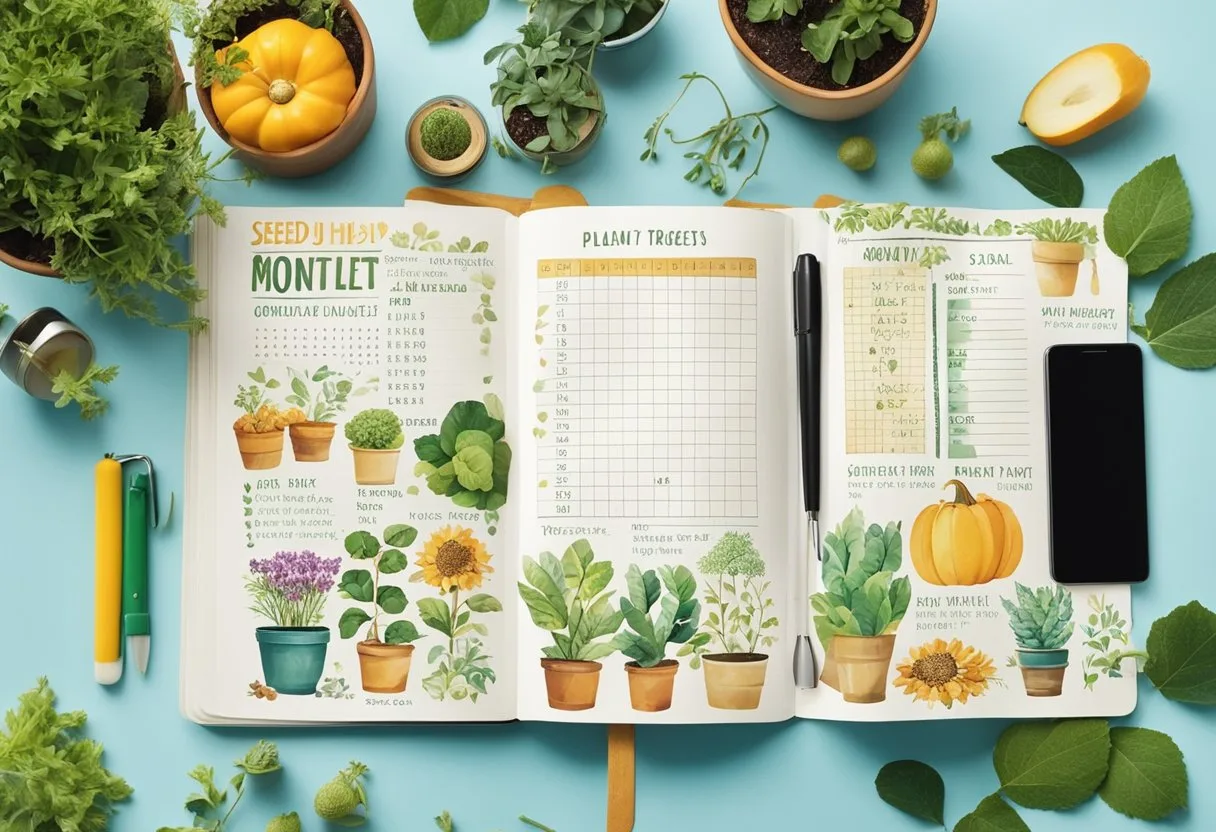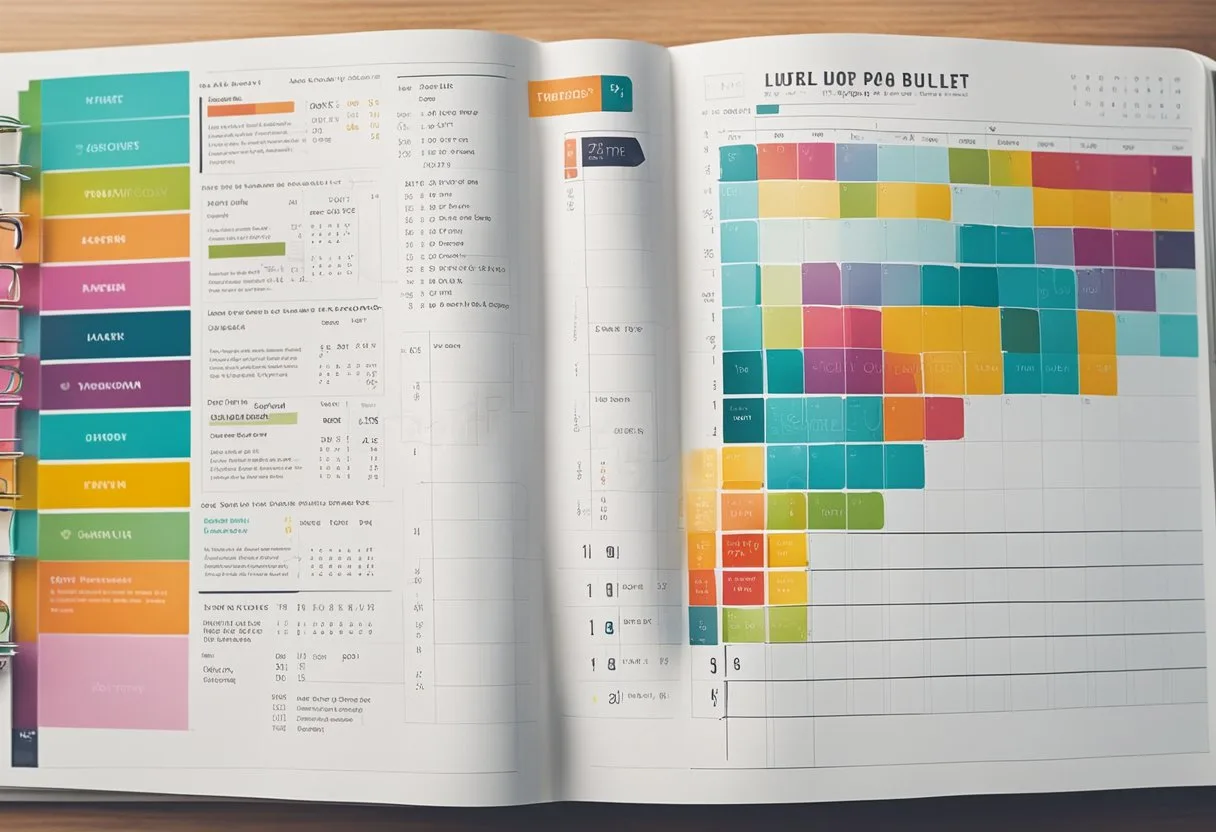Gardening can be a fun and rewarding hobby, but it can also be overwhelming to keep track of all the plants, tasks, and ideas. That’s where bullet journaling comes in. A gardening bullet journal is a creative outlet that can help you stay organized, track your progress, and find inspiration for your garden. In this blog post, I will share with you how to start a gardening bullet journal and provide you 25 ideas to start your gardening bullet journal.
A bullet journal is a customizable planner that uses symbols, lists, and other visual elements to keep track of tasks, goals, and ideas. It’s a great way to stay organized and focused, and it can also be a fun and creative outlet. A gardening bullet journal takes this concept one step further by incorporating gardening-related tasks, ideas, and inspiration into the journal.
Whether you’re a seasoned gardener or just starting out, a gardening bullet journal can be a valuable tool for keeping track of your plants, planning your garden, and finding inspiration. Not only can it help you stay organized and focused, but it can also be a great way to improve your mental health by providing a creative outlet and a sense of accomplishment.
What is a Garden Bullet Journal
A garden bullet journal is a customized notebook that helps gardeners keep track of their gardening activities. It is a simple yet effective tool that can be used to organize gardening tasks, ideas, and progress. Garden bullet journals can be adapted to the needs and preferences of individual gardeners.
Why Start Bullet Garden Journal
Starting a bullet garden journal can help gardeners stay organized and on top of their gardening tasks. It can also serve as a reference for future gardening activities. A garden bullet journal can help gardeners keep track of:
- Plants and seeds to buy
- Projects and ideas
- Sketches of the garden
- Plants that need moving and where to move them
- Weekly/monthly tasks
- Garden inspiration
- Sketches of flowers/trees
- What’s flowering when
- Plans to encourage wildlife into the garden
How to Organize Garden Journals
Garden bullet journals can be organized in different ways depending on the individual gardener’s preferences. One way to organize a garden bullet journal is to use a table of contents to keep track of different sections. Another way is to use color coding to differentiate between different sections or tasks.
What Should be in a Garden Journal
A garden bullet journal should include information that is relevant to the individual gardener’s needs. Some common items that can be included in a garden bullet journal are:
- Garden layout and sketches
- Planting schedules
- Seed inventory
- Plant inventory
- Garden tasks and reminders
- Harvest log
- Pest and disease control
- Garden expenses
A garden bullet journal is a useful tool for gardeners to stay organized and on top of their gardening activities. It can be customized to meet the individual needs of gardeners and can serve as a reference for future gardening activities.
Setting Up Your Gardening Bullet Journal
When it comes to setting up a gardening bullet journal, there are a few things to consider. In this section, we will go over some basic tips to help you get started.
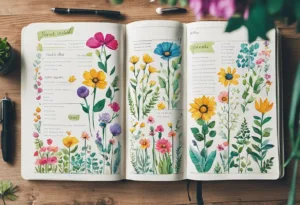
Choosing the Right Notebook
The first step in setting up your gardening bullet journal is choosing the right notebook. When selecting a notebook, consider the size, style, and paper quality. A notebook that is too small may not provide enough space for all of your gardening ideas, while a notebook that is too large may be difficult to carry around. You may want to choose a notebook with a durable cover and high-quality paper that won’t easily tear or smudge.
Basic Layouts and Indexing
Once you have chosen your notebook, it’s time to start setting up the basic layouts and indexing. One of the key features of a bullet journal is the index, which allows you to easily find specific pages and ideas. To create an index, simply number the pages of your notebook and create a table of contents at the beginning.
When it comes to the layout of your gardening bullet journal, simplicity is key. A simple layout will make it easier to find information and keep track of your gardening progress. One popular layout is the monthly spread, which allows you to plan out your gardening tasks for the month ahead.
Garden Planning and Design Sketches
Finally, when setting up your gardening bullet journal, you may want to include garden planning and design sketches. These sketches can help you visualize your garden layout and plan out where to plant different vegetables, herbs, and flowers. You can also use your bullet journal to track the growth and progress of your plants, making notes on how they are doing and what needs to be done to keep them healthy.
Stting up a gardening bullet journal can be a fun and rewarding way to keep track of your gardening progress and plan out your garden design. By choosing the right notebook, creating a simple layout, and including garden planning and design sketches, you can create a useful tool that will help you achieve your gardening goals.
Tracking Your Gardening Journey
Keeping track of your gardening journey is an essential part of successful gardening. A garden journal or bullet journal can help you stay organized, plan ahead, and track your progress throughout the year. Here are some ideas for tracking your gardening journey.
Monthly and Seasonal Logs
Creating a monthly or seasonal log in your garden journal can help you keep track of what needs to be done in your garden each month. You can include tasks such as planting, fertilizing, weeding, and harvesting. It’s also helpful to include notes on weather conditions and any pests or diseases that you’ve noticed in your garden.
Planting and Harvest Records
Keeping a record of what you’ve planted and when you’ve planted it can help you plan your garden for next year. You can include information on the variety of plant, the date planted, and the date of harvest. This can help you determine which plants grow best in your garden and which varieties you should plant again next year.
Garden Maintenance and Tasks
Creating a task list for garden maintenance can help you stay on top of your garden chores. You can include tasks such as watering, pruning, and pest control. It’s also helpful to include notes on any maintenance that you’ve done, such as soil amendments or mulching.
Tracking your gardening journey through a garden journal or bullet journal can help you stay organized, plan ahead, and track your progress throughout the year. Monthly and seasonal logs, planting and harvest records, and garden maintenance and task lists are all useful tools for successful gardening.
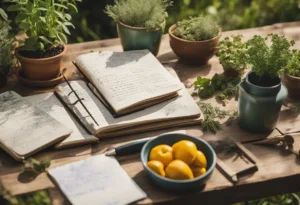
Enhancing Your Gardening Skills
Observations and Successes
One of the best ways to enhance your gardening skills is to observe and learn from your successes. Keep a record of your gardening activities in your bullet journal. This will allow you to track what works and what doesn’t. You can also use your journal to document the progress of your plants and make notes on their growth. This will help you understand what factors contribute to their success.
You can use your journal to record observations about your garden’s environment. Note the amount of sunlight, water, and soil quality. This information can be used to make informed decisions about what plants to grow and where to plant them.
Learning from Failures
Learning from failures is just as important as learning from successes. Keep a record of your failures in your bullet journal. This will allow you to identify patterns and avoid making the same mistakes in the future. Take note of what went wrong, what you could have done differently, and what you learned.
Remember that failures are a natural part of the gardening process. Don’t be discouraged by them. Instead, use them as an opportunity to learn and grow.
Gardening Tips and Quotes
There are many gardening tips and quotes that can help you enhance your skills. Consider adding a section in your bullet journal where you can collect these. You can include tips on everything from soil preparation to pest control. Quotes can be a source of inspiration and motivation.
Here are a few gardening quotes to get you started:
- “The love of gardening is a seed once sown that never dies.” – Gertrude Jekyll
- “Gardening is the art that uses flowers and plants as paint, and the soil and sky as canvas.” – Elizabeth Murray
- “Gardening is the purest of human pleasures.” – Francis Bacon
Remember to always keep an open mind and be willing to learn. With a little bit of effort and some helpful tips, you can enhance your gardening skills and create a beautiful and thriving garden.
Organizing Gardening Resources
Gardening can be an overwhelming task, but with the help of bullet journaling, it can be a manageable and enjoyable experience. Keeping track of gardening resources is essential to ensure a successful gardening experience. Here are some ideas for organizing gardening resources in a bullet journal.
Storing Seed Packets and Plant Tags
One of the essential aspects of gardening is keeping track of the plants’ names, their characteristics, and the conditions under which they thrive. Bullet journaling can help gardeners keep track of all this information.
Gardeners can store the seed packets and plant tags in a file or envelope and attach them to the journal page using washi tape or glue. They can also use a small pocket or a plastic sleeve to store the seed packets and plant tags. This way, gardeners can refer to the information whenever they need it.
Incorporating Photographs and Illustrations
Gardeners can incorporate photographs and illustrations in their bullet journal to help them visualize their garden’s progress. They can take pictures of their plants and stick them in the journal using washi tape or glue. They can also draw illustrations of their plants and label them with their names, characteristics, and growing conditions. This way, gardeners can keep track of the plants’ growth and make informed decisions about their care.
Organizing gardening resources is essential to ensure a successful gardening experience. Bullet journaling is an effective way of keeping track of all the information and resources needed for gardening. Gardeners can store seed packets and plant tags in a file or envelope and incorporate photographs and illustrations to help them visualize their garden’s progress.
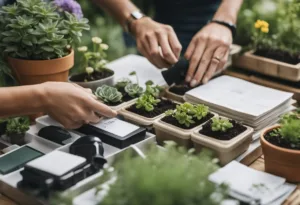
25 Gardening bullet journal ideas
- Garden Layout Planning: Sketch the layout of your garden, including the placement of plants, paths, and structures. Use grid paper to draw to scale and color code different types of plants for easy reference.
- Monthly Task Lists: Create a list of monthly garden tasks such as planting, pruning, and harvesting. Break down the tasks by week to stay organized and on schedule.
- Seasonal Planting Guides: Design a guide for what to plant each season based on your climate zone. Include sowing, transplanting, and harvesting times for each plant.
- Pest and Disease Tracker: Keep a log of any pests or diseases that affect your garden. Note the affected plant, date observed, and treatment applied to monitor the effectiveness.
- Watering Schedule: Set up a watering schedule, considering the needs of different plants and local weather patterns. Use symbols to mark days when watering is needed.
- Fertilization Records: Track when and how you fertilize your garden. Note the type of fertilizer used and the quantity for future reference.
- Garden Budget: Maintain a budget for your garden expenses. Record costs of seeds, plants, tools, and other supplies to help manage your spending.
- Plant Profiles: Create a page for each plant species in your garden. Include information like sunlight requirements, water needs, companion plants, and any specific care instructions.
- Harvest Log: Keep a record of what you harvest and when. This can help you anticipate yields for the following year and plan your planting accordingly.
- Composting Guide: Outline your composting process, including what you can and cannot compost. Track what goes into your compost and its progress.
- Garden Inspirations: Dedicate pages to garden designs and ideas that inspire you. Include photos, sketches, or magazine clippings.
- Seed Inventory: Keep an inventory of your seeds, including the type, brand, purchase date, and germination rate. This helps with planning and ensures seeds are used before they expire.
- Garden Journal: Write regular entries about your garden’s progress, weather conditions, and personal observations. This can be a valuable resource for reflection and future planning.
- Bird and Wildlife Sightings: Note the different types of wildlife visiting your garden. This can be both enjoyable and useful for understanding your garden’s ecosystem.
- Garden Goals: Set short-term and long-term goals for your garden. Review and update them as you make progress or your interests evolve.
- Tool Maintenance Log: Keep track of maintenance and repairs for your gardening tools. Note dates of service to keep them in good condition.
- Irrigation System Map: If you use an irrigation system, map out its layout. Include details like hose lengths and emitter locations for easy troubleshooting.
- Weather Tracker: Record daily weather conditions to see how they affect your garden. Over time, this can help you make more informed gardening decisions.
- Soil Amendment Records: Note when you amend your garden soil and what materials you use. This helps maintain soil health and fertility.
- Propagation Records: If you propagate plants, keep details of your methods and success rates. This can include cuttings, division, or seed starting.
- Garden Quotes and Reflections: Reserve space for motivational quotes and personal reflections. Gardening can be meditative, and this space can enhance that aspect.
- Plant Wishlist: Keep a list of plants you want to add to your garden. Research their needs and characteristics to plan where and when to incorporate them.
- Garden Visits: Document gardens you visit for inspiration. Note plants, layouts, and features you might want to try in your own space.
- Garden Experiments: If you like to experiment with new techniques or plant varieties, dedicate pages to track your trials, observations, and results.
- Yearly Review: At the end of each growing season, review what worked and what didn’t. Use this information to plan improvements for the next year.
Tips for Using Bullet Journal Ideas for Gardening
Bullet journaling is a great way to organize and plan your gardening activities. Here are some tips to help you get started and make the most of your gardening bullet journal:
- Keep it simple: Start with a basic layout and add details as you go. Avoid making your journal too complicated, as it can become overwhelming and difficult to maintain.
- Use symbols: Use symbols to represent different tasks or events in your garden, such as planting, watering, and harvesting. This will help you quickly identify what needs to be done and when.
- Create a key: Create a key that explains the symbols you use in your journal. This will help you remember what each symbol means and make it easier to use your journal.
- Track your progress: Use your journal to track your gardening progress, such as when you planted seeds, when they sprouted, and when you harvested your crops. This will help you identify what works and what doesn’t in your garden.
- Plan ahead: Use your journal to plan ahead for the coming seasons, such as what you want to plant and when. This will help you stay organized and ensure that you have a successful garden.
- Make it personal: Customize your journal to fit your personality and gardening style. Add personal touches, such as quotes or drawings, to make it more enjoyable to use.
- Use it regularly: Use your journal regularly to stay on top of your gardening tasks and ensure that your garden stays healthy and productive. Make it a habit to update your journal at least once a week.
Frequently Asked Questions
What are the essential elements to include in a garden journal?
A garden journal should include essential information such as the date of planting, the type of plant, and the location of the plant. It should also include information about the soil, the amount of water and sunlight the plant needs, and any pests or diseases that may affect the plant.
How can beginners effectively utilize a bullet journal for garden planning?
Beginners can utilize a bullet journal for garden planning by creating a simple layout that includes a future log, monthly and weekly spreads, and a plant tracker. They can also customize their journal with personal touches and use it to track their gardening progress.
Can you recommend any simple layouts for tracking plant growth in a bullet journal?
A simple layout for tracking plant growth in a bullet journal is to create a chart that includes the date of planting, the type of plant, and the growth progress. Another layout is to create a grid that includes the date of planting, the type of plant, and the number of leaves or flowers.
What are the best practices for journaling about garden design and layout?
The best practices for journaling about garden design and layout are to sketch out the garden design and layout, make notes about the plants and their placement, and include any changes or adjustments that may need to be made. It is also helpful to include pictures of the garden and any inspiration or ideas.
How do garden planning tools integrate with bullet journaling for efficient garden management?
Garden planning tools can integrate with bullet journaling for efficient garden management by providing a template or layout for the bullet journal. This can help streamline the process of garden journaling and provide a more organized and efficient way of managing the garden.
What templates can help streamline the process of garden journaling?
Templates that can help streamline the process of garden journaling include a future log, monthly and weekly spreads, a plant tracker, and a garden design and layout template. These templates can be customized to fit the individual’s needs and preferences and can help make the process of garden journaling more efficient and organized.

